Reviews
Review: White Knight Chronicles
March 29, 2010, Author: Giuseppe Nelva
In the wake of the release of Final Fantasy XIII it’s hard to find anyone writing or discussing any other JRPG. Last month, though, saw the western release of another potentially interesting title: White Knight Chronicles. While not as graphically alluring as the Square Enix masterpiece, having been published in Japan more than one year ago, ‘Shirokishi Monogatari’ still stands out as it brings several innovations to the JRPG genre.
That level of innovation has been the cause of an initially mild response in Japan, alongside a few shortcomings that have been integrated and patched in the following months and are included in the western release. It is a whole different beast compared to what was released in Japan two holiday seasons ago; much more polished and complete. Despite its new approaches, though, White Knight Chronicles is still a JRPG developed in Japan, triggering the usual biased and overly-negative approach from the western press and ending in an absolutely undeserved Metacritic average of 64.
When a game scoring so low has an user score of 83, it’s fairly easy to notice that something is amiss, and guess what, that something is probably to be found in the “official” press scores.
Once upon a time in the realm of Balandor…
The story is basically the only element that’s not a great departure from what you know about JRPG’s. Quite similar to the old glorious anime series Escaflowne, it portrays a mix between classic fantasy JRPG canon and giant robot anime. The young winery errand boy Leonard finds himself trying to rescue a princess from a kidnapping attempt by gaining control of a massively sized armour defined “Knight” that he will use to increase his fighting strength tenfold. Unfortunately his rescue attempt ultimately fails and the princess does get kidnapped by a mysterious organization named “Magi”, prompting Leonard to set off to a desperate rescue mission with the help of several companions, delving deeper in the legend of the Knights and his own heritage as his quests progress.
While not very original, the story is enjoyable, even thanks to a few unexpected plot twists (and a few more predictable, but still interesting ones). It doesn’t reach truly and massively epic proportions, but creates a very good staging ground for the franchise that’s obviously set to continue. The plot is more focused on the small scale, showing the adventures of Leonard (and his personal growth), his companions and the rescue of the princess, more than the overall war against the Magi. While I personally don’t find that a bad thing, I can understand why some gamers, used to playing a “one shot” game that will begin and end on the same disk, found it disappointing. Luckily for them, given the ending and what little we’ve seen of White Knight Chronicles 2, the focus is going to broaden considerably in the sequel, bringing the franchise to those “epic proportions” that many seek.

Who wouldn't want his own personal giant robot?
… A boy was tasked with an epic mission…
The world of White Knight Chronicles definitely isn’t linear, which can be found to be more original in this generation of JRPG’s. While not being completely Oblivion-like seamless, and requiring the player to travel through the usual world map, each separate area is extremely expansive and complex, rewarding exploration and inviting the player to experience the beauty of the landscape instead of just travelling from point A to point B in the shortest possible time. Fans of linear gameplay will still be able to just aim for the next story marker in the map, of course, but gamers that enjoy sandbox-like exploration won’t be disappointed. After the first playthrough several new chests will appear during the ‘new game plus’, rewarding exploration-oriented adventurers with some truly spiffy pieces of equipment.
Once unlocked, all of the areas of the world remain available, allowing the player to go back and perform more quests, open previously missed chests or kill more monsters. The monsters themselves are fully visible in their roaming and constantly respawn. Most of the times they can be avoided easily, even though I wouldn’t advise to do that, in order to level up the characters smoothly. Monster design is more or less average overall, but truly shines with giant monsters, that will tower over human-sized characters, often much bigger than the screen. They also sport some truly inspired looks, like the ever-present trolls and giants, that while being fairly common, will never become boring simply because they look really good.
One of the most innovative elements of White Knight Chronicles is the character creation. While you won’t be able to customise the look of the main character Leonard, you will be given an in-game “avatar” that will play the role of Leonard’s silent sidekick (and will be your playable character online but I’ll talk about that later). The customisation process is actually one of the most advanced I ever seen in a videogame, putting even western RPGs, including Oblivion or Dragon Age, to shame, allowing the player to fully design both the body and the face of his character up to an unprecedented level of detail. This feature that’s normally found only in western RPGs, definitely breathes some fresh air into the genre, and I really hope that other developers will follow Level 5’s example.
The only flaw of this solution is that your “silent sidekick” is truly silent. While he’s definitely useful during battles and appears during the cut-scenes performed with the game-engine (not the CG ones), he never talks nor does much to get his presence noticed. Despite that, the system is solid and has a lot of potential, potential that will be probably exploited fully in the sequel, as Level 5 already announced that the sidekick will gain a bigger role in the story and will even acquire his own knight. It’s pretty much safe to assume, given the fact that it’ll be usable online, that such knight will be customisable as well. A JRPG that lets us customise our character and even our personal giant robot? Yes, thank you!
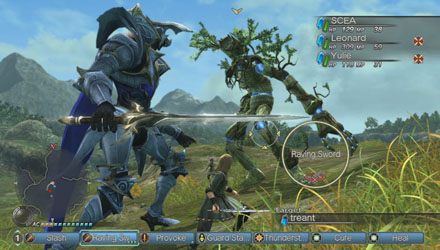
Time to cut some branches!
Visual customisation similar to western RPGs isn’t limited to the sidekick character’s personal looks: unlike almost every other JRPG, in which the only piece of equipment that visually changes is the weapon, every piece of armour you wear on any character (including Leonard and the other pre-made story characters) will actually be visually displayed, changing his or her appearance radically in a really beautiful and rewarding way. Gamers that normally have problems stomaching JRPG characters usually quite… peculiar sense of fashion will definitely be happy about this.
Let’s be honest here. There’s very little more rewarding while progressing through a game than seeing your characters move on from their initial rags and start being geared in some shiny heavy armour. Visual customisation goes as far as allowing characters to wear capes and cloaks (something that even most western RPGs don’t include). The only sorely missing element in the bunch are helms and equivalent pieces of headgear, but now I’m really nitpicking, even because the presence of helms would probably take away from the complex facial customization feature. That said, having the chance to choose if to wear headgear or not would be definitely appreciated, so I remain hopeful for the sequel.
Continuing the trend of customization, White Knight Chronicles radically distinguishes itself from other JRPG’s even in character progression. While the classic mechanism of experience and levels remains, and levelling up does automatically assign a few stat points, the game involves one of the most complex and interesting open-ended skill systems I’ve seen in an RPG (Western or Japanese). No character comes with a pre-defined class or role. Instead, for every level you gain, you will be able to assign four skill points to one of the eight available skill trees: Sword, Greatsword, Staff, Spear, Bow, Axe, Arcane Magic and Divine Magic.
Each tree includes about fifty options between attacks, abilities, spells, buffs and stat increases for a grand total of 398 available (about 300 for the pre-made characters, that don’t have access to two of the skill trees, in order to provide some characterisation I guess). The system is so complex and deep that there’s no real “cookie-cutter” build for characters, and it’s easy to build an effective character for any given role while catering to one’s own visual tastes and style.
The stat increases included in each skill tree make them interdependent, meaning that even if you want to specialise in a role, rising other trees will still help you become more effective in that role by raising stats associated with it, making variation and experimentation a true corner stone of this title. For instance, if you want your character to be a tank (shield-user focused on defence and protection of his companions), you’ll probably want to concentrate on the spear and sword trees, which are the most defensive. Then you might find yourself wanting to spend further points in Axe in order to raise your HP and Strength, or maybe divine magic, that raises Vitality and gives you some useful self-healing abilities and buffs. A respect system at the end of the single player story also allows you to change roles and builds with a certain ease, encouraging experimentation. If you find yourself daunted by such an extensive system, you can find some pretty useful tips and data here and here.
Natural offspring of the skill system is the combat system. While some lamented the fact that the time-lapse between actions is pretty long (3-4 seconds in average), I found White Knight Chronicles’ combat system very tight. The interval between attacks is actually fully justified by the abundance of buffs, skills and attacks at your disposal. With such a wealth of available actions, a slow approach rewards tactical and rational thinking instead of the usual bored button mashing you see in several games of this kind.
The crown jewel of this combat mechanic is the combo system, that allows you to prepare long (or short) chains of attacks and spells to unleash on the helpless (not really) monsters you’ll face for devastating damage, allowing players to truly create their unique fighting style and to adapt in a tactical way according to the enemy they’re facing. Not only magical attacks have elements against which monsters can be weak or resilient, but even physical attacks can rely on thrusting, slashing and hitting, with varying damage according to each enemy’s strengths and weaknesses. Creating a wide array of generic and specialised combos of varied length allows proficient players to maximize their damage output with a level of depth than even the most advanced MMORPGs often fail to reach. While generic combos are good for fighting enemies whose weaknesses you don’t know, and to gauge them in the case you don’t have a bow user in your party, specialised combos that concentrate on one damage type can be more devastating, provided that the enemy is weak to that kind of attack.
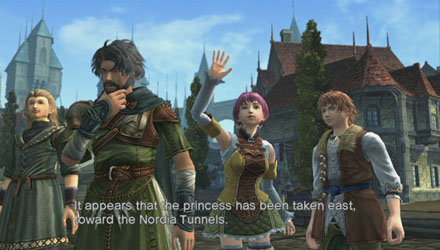
Time for some shopping!
A further level of complexity is provided by armour, which doesn’t only vary in protection and looks, but also in weight. Fighting in heavy armour causes your attack bar (it’s actually a circle) fill slower, while light armour will let it fill much faster and will allow you to attack much more often, making for an approach more appeasing to twitchy players. Of course, basic monsters don’t really require that kind of deep approach, but almost indispensible while fighting giant-sized monsters.
This is where the White Knight Chronicles combat truly shines. You can either decide to fight them in your knight (just offline), or on foot. The first option will allow for more spectacular giant-robot vs giant-monster fights, but will be pretty easy even for beginners. The second may lessen the fireworks, but it’s more challenging and it’s still important to the single player story because the use of the knight is limited and you’ll still find several giant monsters about even outside of boss fights. This kind of combat is very fun, thanks to how giant monsters behave and animate. Initially human-sized characters with melee weapons will be able to target only the monster legs while the enemy will tower over them and bash them around like puppets with devastating attacks. As the damage builds up, the monster will finally stagger and fall on his knees, becoming temporarily incapacitated and allowing melee characters to target his more vulnerable chest and head.
Summing the whole system up, boss and giant fights in White Knight Chronicles make for some of the most interesting and visually appealing fights between the JRPG genre (and between RPGs in general), especially online, where some of the enemies prove to be really, really tough and party coordination and focus are a must. Another partly innovative detail for a JRPG is the implementation of a full fledged physics engine (Havok). Very often turn-based JRPGs don’t need one, causing the developers to completely overlook its implementation or to include only limited physics. A full-fledged physics engine, though, allows for a deeper character and environmental interaction, with blows that can realistically bash enemies around or throw them into the air, collision detection and similar features that greatly enhance the game both visually and gameplay-wise.
… and departed to the vast, lush countryside…
While the game’s graphics look a little dated if compared with newer titles of an AAA level, they’re still very adequate and better than most JRPG’s published this generation (Final Fantasy XIII excluded of course). Level 5 adopted an approach fairly similar to what Bioware did with Dragon Age: Origins. The level of detail of characters and monster isn’t exceptional, while the environments are much richer. It’s in the portrayal of the vast landscapes that White Knight Chronicles shines, with beautiful sights and immersive environments that will make you feel truly dwarfed by massive chasms and titanic ruins, perfectly in line with the fact that the main character is able to “pilot” what essentially is a fantasy version of a giant robot.
The design of the knights is, as well, definitely beautiful, after all the Japanese have no rivals in mecha design, and White Knight Chronicles is no exception. The design of the UI is definitely more adequate than what we saw in most of this generation’s JRPG games, with some very elegant choices, that, while not reaching the utter glitz of Final Fantasy XIII, put White Knight Chronicles definitely above the average. One of the most shiny elements of the game are the beautiful CG cut-scenes, that portray some of the most important story points with a stunningly rich level of detail.
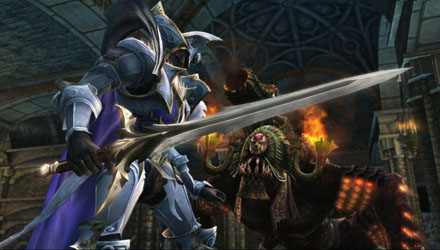
Nice doggy... here doggy...
…to create the stuff of ballads and legends…
The soundtrack is definitely adequate, while not exceptional, and nicely underlines all the situations of the story and the atmosphere of the varied environments. A mention of merit goes to the theme song “Travelers“, sung by Kazco Hamano, that puts together a beautiful and energetic voice, J-pop overtones, classical guitar and flute in a perfectly appropriate mix that really suits the game. I definitely approve the choice to keep the original Japanese song in the international release instead of replacing it with a generic English one like Square Enix did with Final Fantasy XIII.
Moving on to a more marginal, but still interesting, touch, a very enjoyable detail is party banter, more or less akin to what implemented in Dragon Age: Origins. Your characters will often talk to each other outside of cut-scenes, just while walking around. While each line is usually shorter than the long winded dialogues in Bioware’s masterpiece, they definitely happen more often. While in DA:O party banter was triggered by walking through specific points (usually bridges, for some mysterious reason), White Knight Chronicles uses a solution that I personally deem simpler but more effective, having banter triggered by a timer. Another cute detail is that banter will see every member of the party taking part in it. So, when someone will say or ask something everyone else will comment, instead of limiting the dialogue to two characters like in Dragon Age.
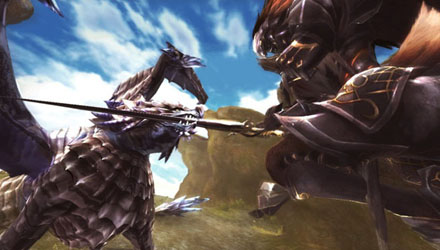
Dragon hunting is the duty of every knight... or is it?
… then he was joined by valiant companions.
Let’s finally get to the true big innovation brought by White Knight Chronicles to the JRPG genre: Online gameplay. White Knight Chronicles features a full fledged suit of online features that increases its longevity tenfold. It’s something definitely new to the JRPG genre and that actually happens quite rarely even in the west. Your first contact with such features will probably be the Georama. Near the beginning of the game you will be prompted to buy the deed to a fully fledged personal village. Once purchased you will be able to use the money and materials you gather through the game to expand and beautify your little hamlet by adding more buildings and decorations.
In addition to that, several of the NPCs you will encounter during your travels in the single player world can become your villagers. Once recruited they will form the population of your village and provide labour force to fuel your markets. Each villager has his own stats, and clever administration will allow you to produce top-tier materials and equipment that would be otherwise inaccessible.
Eventually you will be tempted to actually sign in into Geonet, the White Knight Chronicles dedicated online environment. There you will be able to create your own homepage centred around your Georama that will also allow you to access to a message board, your friend list and a photo-sharing feature. I actually wish that every game of this genre had such an image capture utility. Unfortunately there’s no way to download the pictures on a PC, and that’s a truly sad limitation.
Another quite annoying limitation is that the friend list is specific to the game and it’s not shared with your PSN friend list, hampering functionality a little. Anyway, once your homepage and your Georama are ready (it’s actually not mandatory to customize them,), you can finally look for some action. You can sit in your own Georama waiting for people to come, or you can use the built-in search engine to find Georamas of other players with a similar level. Once you found one you can visit it and meet with them and other guests, eventually forming a party of four and departing to face one of the many online quests offered by the game. Some of them can be even soloed, but of course it’s much more fun to tackle them with friends. Full voice communication is supported by the game via bluetooth headset, so party coordination isn’t a problem.
The way online gameplay is integrated with the offline story is probably the best element of this game, allowing you to seamlessly drop into an online session whenever you like, and then go back to the main story like nothing happened, using the same character. The only missing feature would be a cooperative gameplay mode for the main campaign, but unfortunately Level 5 didn’t think about it. Maybe food for thought for the sequel.
A very interesting fact is that Sony and Level 5 aren’t content to just sell the game as a complete package, but are actually going to offer new free weekly quests until June 2010, adding a quite unprecedented level of free support to an already very content-rich game. This is a definitely praise-worthy initiative, that adds quite a lot of value and longevity to the original game, and lets us have high hopes about the future of the franchise.
As a final marginal note, if you’re an user of Playstation Home, White Knight Chronicles is an example of how the platform should actually be used paired with trophies. By achieving a certain trophy during gameplay you will be awarded a nice statue of the White Knight that you will be able to use to decorate your Home personal space. A nice step in the right direction.
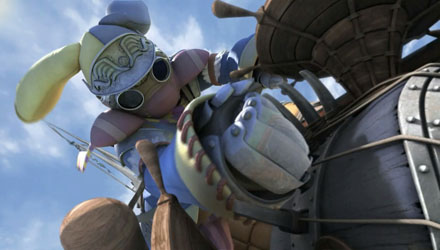
The crown jewel of Balandorian fashion sense...
Where will his quest lead him?
In conclusion, if you are a JRPG fan and a little dated character graphics aren’t your main concern, White Knight Chronicles is most definitely a worthy contender for a spot in your collection. If your tastes lean more towards western RPGs, you’ll still find quite a few elements that aren’t normally included in JRPGs and that will very possibly cause you to love this title. Also, if you enjoy online cooperative gameplay, you shouldn’t miss this title.
It’s not a perfect game, but it’s a very good step in establishing a franchise with several features that truly push the JRPG genre towards a new direction. It’s quite a pity that a sizable part of the press, while often insistently demanding innovation from JRPGs, didn’t manage to actually spot it when they had it right in front of their eyes, preferring to nitpick on marginalities.
Given the recent news about Level 5 working hard on the evolution of a faster, more dynamic combat system for the second chapter of the series, you probably don’t want to miss the first, in order to fully enjoy what seems to be destined to become a classic JRPG saga.
Platforms: PS3 | Tagged JRPG, Level 5, PS3, Sony, White Knight Chronicles



